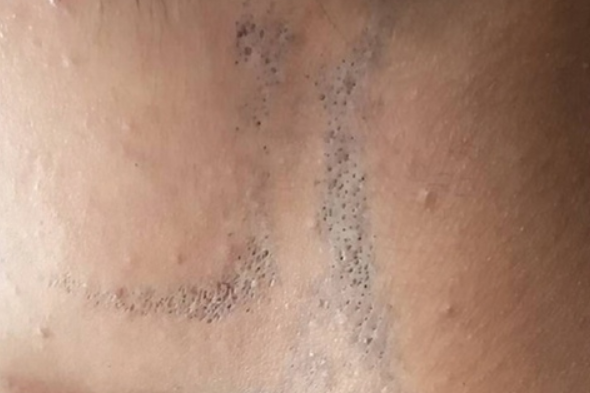Nevus Comedonicus - a rare condition caused by a defect in the pilosebaceous apparatus, characterized by the presence of large comedones grouped in clusters or linearly. ICD-10 code: Q82.5.
In about half of the cases it is present at birth, in others it appears between the ages of 10 and 15. The incidence is 1 case per 45,000 dermatologic conditions.
Etiology and pathogenesis are unknown. Some authors consider comedonal nevus to be a hamartoma resulting from abnormal development of the mesodermal part of the follicular-sebaceous unit with subsequent abnormal epithelial differentiation. The formed follicular structures are unable to form healthy follicles or sebaceous glands, producing only soft keratin, which accumulates in the follicular openings, leading to comedo-like eruptions. Others believe it is a form of epidermal nevus.
The clinical presentation of nevus comedonicus is characterized by a limited area of involvement within which are densely packed follicular papules slightly elevated above the skin surface. The central portion of these papules is punctured by a dense keratin plug of dark gray or black color. Forceful removal of the keratin plug results in a depression, leaving behind atrophy. Secondary inflammation and suppuration of the affected areas (inflamed comedonal nevus) are often observed. Comedonal nevi are mainly localized on the skin of the limbs and trunk, less often on the face. Segmented, linear forms of nevus with unilateral, bilateral and Blaschko's lines distribution have been noted.
In comedonal nevus syndrome, the following are most commonly observed
- Nervous system involvement (dysgenesis of brain structures, microcephaly, Weber syndrome).
- Skeletal anomalies (polydactyly, absence of the fifth finger, rudimentary toe, scoliosis, bone hypertrophy, bone cyst, kyphosis, vertebral clefting, oligodontia, vitamin D-resistant rickets).
- Trichilemmal cysts, eccrine spiradenoma, and hidradenoma
- Cataract.
- Alagille Syndrome.
- Comedones in Acne
- Epidermal nevus
- Porokeratosis of Mibelli
- Atrophoderma vermiculata
- Favre-Racouchot syndrome
Excision or electrosurgery.
Laser therapy (CO2 laser, diode laser with a wavelength of 1450 nm).
Minor eruptions may improve with the topical application of retinoic acid preparations (0.1% tretinoin cream), salicylic acid, and ammonium lactate.

